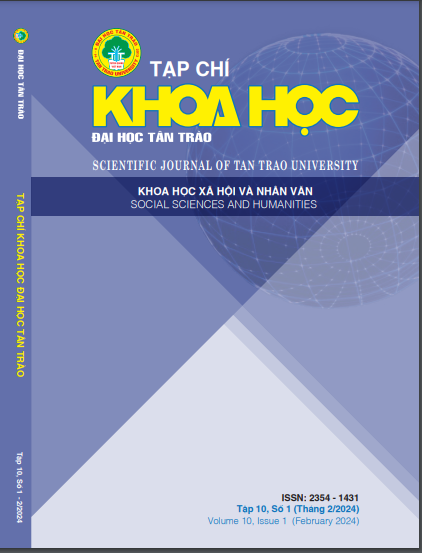COMPARING THE MEANING OF活/SỐNG IN CHINESE AND VIETNAMESE FROM THE PERSPECTIVE OF COGNITION
DOI:
https://doi.org/10.51453/2354-1431/2024/1071Keywords:
Keywords: 活/sống, Chinese language, Vietnamese language, cognition, semanticsAbstract
Abstract: Through investigation and comparison of words containing the character 活/sống in both Chinese and Vietnamese languages, we can explore the implicit notions and semantic characteristics of these words from the standpoint of cognitive semantics and the mapping of concepts in the process of constructing meaning. Additionally, we can explain the similarities and differences in cultural and national thought patterns deeply embedded in the cognitive mechanisms of Chinese and Vietnamese people regarding the semantics of words containing the element 活/sống using descriptive, statistical, comparative, and synthetic analysis methods. These suggestions can be valuable when teaching modern Chinese language in Vietnam.
Downloads
References
Hoang Phe, (2015). Vietnamese dictionary. Da Nang Publishing House, Da Nang.
Lam Quang Dong (2017). Interpretation of the development of the meaning of the verb “run” in the cognitive direction. Journal of Foreign
Studies, 33(4), 45-57.
Nguyen Lan (2014). Dictionary of Vietnamese idioms and proverbs. Literature Publishing House, Hanoi.
Nguyen Thi Thanh Huyen (2009). Cognitive metaphor, Structural metaphor model based on Trinh Cong Son’s lyrics data. Master,
University of Social Sciences and Humanities, Ho Chi Minh City.
Tran Van Co (2007). Cognitive linguistics (notes and thoughts). Social Sciences Publishing House, Hanoi.
周淑萍(2020).先秦汉唐孟学研究.中华书
局,北京. (Zhou Shuping (2020). Nghiên cứu Mạnh học thời Tiên Tần Hán Đường. Trung Hoa thư cục, Bắc Kinh.)
谷衍奎(2008).汉字源流字典.语文出版社,
北京.(Gu Yankui (2008). Tự điển nguồn gốc chữ Hán. Nxb. Ngữ văn, Bắc Kinh.)
许慎原著;汤可敬撰(1997).说文解字今 释.岳麓书社,湖南. (Nguyên tác Xu Shen, Tang Kejing viết (1997). Giải thích Thuyết văn giải tự. Nxb. Nhạc Lộc Thư xã, Hồ Nam. )
杜广慧(2018).副词“活”字溯源.兰州教育学 院学报,(34),87-89. (Du Guanghui (2018). Truy nguyên gốc từ của phó từ “huo”. Học báo Học viện Giáo dục Lan Châu, (34), 87-89.) 王天佐 (2010). “死活”考释.汉字文化, (06)
,77-79. (Wang Tianzuo (2010). Khảo sát và giải thích về hai chữ “si huo”. Văn hóa Hán tự. (06), 77-79.)
卢植(2007).认知与语言——认知语言学 引论.上海外语教育出版社,上海. (Lu Zhi (2007). Tri nhận và ngôn ngữ - Dẫn luận ngôn
ngữ học tri nhận. Nxb. Giáo dục ngoại ngữ Thượng Hải, Thượng Hải.)
徐盛桓(2002).常规关系与认知化——再论常规关系.外国语,(1),6-16. (Xu Shenghuan (2002). Quan hệ thường quy và tri nhận hóa-lại bàn về quan hệ thường quy. Ngôn ngữ nước ngoài, (1), 6-16.)
熊学亮(2001).认知语言学简述.外语研究,(3),11-25. (Xiong Xueliang (2001).Khái lược về ngôn ngữ học tri nhận. Nghiên cứu ngoại ngữ, (3), 11-25.)
李学勤(2013).字源.辽宁人民出版社,沈阳. (Li Xueqin (2013). Tự nguyên. Nxb. Nhân dân Liêu Ninh, Thẩm Dương.)
沈铭贤(1997).“生 死 俱 善 ,人 道 毕矣”——中国古代的生死观及其现代意义.上海社会科学院学术季刊, (2),99-107. (Shen Mingxian (1997). “Sinh tử cụ thiện, nhân đạo tất hĩ”-Quan niệm về sống chết thời cổ đại của Trung Quốc và ý nghĩa trong thời hiện đại. Quýsan học thuật của Học viện Khoa học xã hội Thượng Hải, (2), 99-107.)
邬可晶(2019).孔子与天命.中华文史论丛,(4),97-152. (Wu Kejing (2019). KhổngTử và thiên mệnh. Tuyển tập văn sử Trung Hoa, (4), 97-152.)
中国社会研究院语言研究所词典编辑室(2006).现代汉语词典(第5版).商务印
书馆,北京. (Phòng biên tập từ điển, Trung tâm nghiên cứu ngôn ngữ thuộc Viện Nghiên cứu xã hội Trung Quốc (2006). Từ điển Hán ngữ hiện đại (Bản số 5). Nxb. Thương vụ, Bắc Kinh.)
Downloads
Published
How to Cite
Issue
Section
License

This work is licensed under a Creative Commons Attribution-ShareAlike 4.0 International License.
All articles published in SJTTU are licensed under a Creative Commons Attribution-ShareAlike 4.0 International (CC BY-SA) license. This means anyone is free to copy, transform, or redistribute articles for any lawful purpose in any medium, provided they give appropriate attribution to the original author(s) and SJTTU, link to the license, indicate if changes were made, and redistribute any derivative work under the same license.
Copyright on articles is retained by the respective author(s), without restrictions. A non-exclusive license is granted to SJTTU to publish the article and identify itself as its original publisher, along with the commercial right to include the article in a hardcopy issue for sale to libraries and individuals.
Although the conditions of the CC BY-SA license don't apply to authors (as the copyright holder of your article, you have no restrictions on your rights), by submitting to SJTTU, authors recognize the rights of readers, and must grant any third party the right to use their article to the extent provided by the license.


